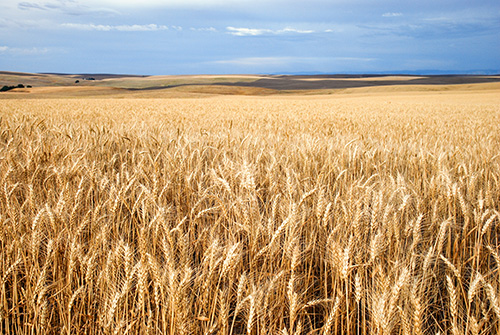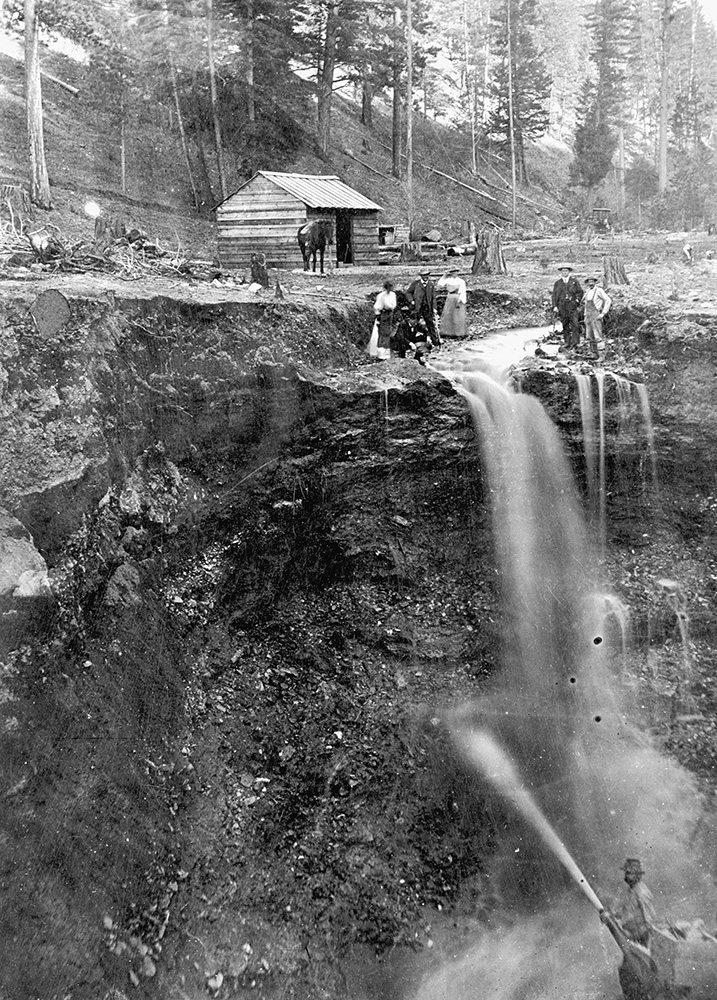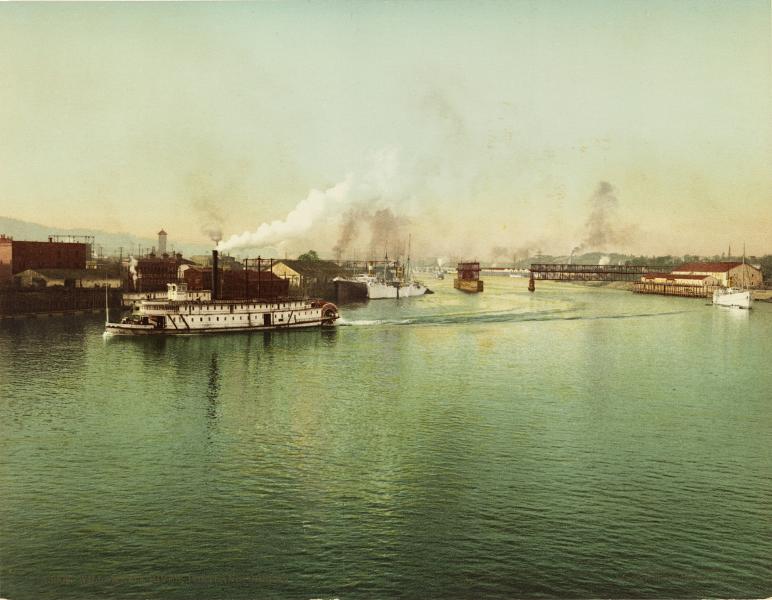Water Management

A wheat field in Umatilla County on the Columbia Plateau. (Oregon Scenic Images collection)
A wheat field in Umatilla County on the Columbia Plateau. (Oregon Scenic Images collection)Transportation revolutions in Oregon accelerated ongoing transformations of the state’s environment. Oregon’s farmers and ranchers expanded and intensified their tilling, planting, grazing and other productive efforts. West of the Cascades, plentiful water created a lush and fruitful environment, but it caused farmers plenty of problems, too. Abundant rain and overflowing streams soaked the soil and ruined crops, and farmers could not extend their fields into marshes, wetlands and commonly flooded areas. Although they could not control the water falling from the sky, farmers managed it once it hit the ground: they built protective dikes to restrain rivers and dug ditches and ran underground pipes to drain water from fields, creating more cultivable land planted with wheat and other crops for market. East of the Cascades on the Columbia Plateau, insufficient water meant fewer transportation options and the inability to grow the thirsty crops that thrived in the Willamette Valley. Railroads, financed and controlled by capitalists and managers in Eastern centers of capital, helped solve the first problem; farmers overcame the second by developing small-scale irrigation projects and by planting winter wheat, a hardier but still profitable crop. Farmers on the Columbia Plateau were soon growing more wheat than their competitors west of the Cascades. Southeastern Oregon was too remote and too dry for wheat, but cattle and sheep ranching grew and flourished on a massive scale. By 1900, more than 15,000 cattle and 400,000 sheep roamed Harney and Malheur counties. Again, railroads allowed and encouraged this expansion. The Central Pacific’s shipping facility at Winnemucca, Nevada and the Union Pacific’s tracks into eastern Oregon gave ranchers access to markets in San Francisco, Chicago and beyond.
Industrial Technology
 Onlookers stand above a hydraulic gold mining operation in the late 1800s. (Courtesy of Oregon Historical Society)
Onlookers stand above a hydraulic gold mining operation in the late 1800s. (Courtesy of Oregon Historical Society)As Oregon’s fields and rangelands industrialized, so did its hillsides, forests, rivers and ocean. Equipped with new technology, often powered by steam, miners, loggers, fishers and manufacturers asserted more control over Oregon’s environments and the wealth they contained. After the placer miners had taken all the “easy” gold from southern and eastern Oregon stream beds during the early mining booms, larger-scale operations took their place. Industrial miners, working for corporations overseen by external investors, dynamited their way into mountains and then used machines to crush and smelt precious mineral-bearing ore, or rechanneled streams and built high-pressure water cannons to wash away hillsides that were then sifted through for gold. Industrial technology and market forces increased timber production, too. Strong cross-cut saws replaced axes to fell trees, small railroads and “steam donkey” machines replaced real animals pulling logs out of forests, and steam-powered mills replaced water-powered mills to turn logs into marketable timber.
Equipped with such technology, timber companies with headquarters in Minneapolis, San Francisco, the Puget Sound and elsewhere reached into previously inaccessible forests—stands of Douglas fir in the Nehalem Valley, for example, and Ponderosa pine in Klamath and Deschutes counties—and cut down as many trees as the market could handle. Oregon’s rivers also became industrial sites for the harvesting and processing of salmon traveling to and from the Pacific Ocean. In the last quarter of the 1800s, fishers constructed a gauntlet of salmon harvesting technologies on the Columbia River: nets, traps, weirs, seines and fish wheels that took out hundreds of thousands of pounds of salmon. Oregon’s salmon canning industry grew quickly, from 4,000 cases in 1866 to a high of 620,000 in 1884. The state took a variety of measures to conserve fish populations; for example, in 1898, the state legislature passed a law that regulated salmon fishing and encouraged salmon propagation through hatcheries and the removal of fish passage barriers. Such efforts sought to allay concerns about the potential exhaustion of natural resources that might result from the transformation of Oregon’s rivers, forests, hillsides and fields.
The timber, ore, grains and fish coming out of Oregon’s environments traveled on railroads and waterways toward Oregon’s growing and increasingly diverse cities and towns. Portland quickly became Oregon’s largest city and commercial hub, thanks to its location at the confluence of the Willamette and Columbia rivers and its citizens’ aggressive and successful efforts to attract railroads to the city. From a population of less than 3,000 in 1860, Portland grew into a metropolis of 90,426 by 1900. The state’s financial power also centered on Portland, home to the state’s first bank and its richest citizens. Other cities and towns developed along rivers and railroads during the 1800s, too, including Astoria (population 8,381 in 1900), Baker City (6,663), Pendleton (4,406), and Salem (4,258). In towns both big and small, Oregonians busily transformed the products of the state’s environments. To serve markets near and far, a variety of manufacturing and processing industries developed, from flour and woolen mills to fish canneries and brick factories. Urban areas also offered many other commercial and retail services: printers, blacksmiths, bankers, launderers, bakers, carpenters, photographers and more, depending on the size and age of the town.

Portland grew rapidly in the decades around 1900 as immigrants swelled the population. This 1901 photo shows the Willamette River in Portland. (Courtesy of the Smithsonian Institution)
Portland grew rapidly in the decades around 1900 as immigrants swelled the population. This 1901 photo shows the Willamette River in Portland. (Courtesy of the Smithsonian Institution) While power over these industries and enterprises rested in the hands of elites in Portland, San Francisco, New York, and other centers of capital, the actual transformation of environments came at the hands of old and new immigrants alike, drawn to natural resource extraction work in the countryside and commercial and manufacturing jobs in Oregon’s cities. Oregonians of western European descent generally welcomed and quickly integrated other immigrants from the countries of their homeland, including the United Kingdom, Germany, and Scandinavian nations. Other immigrant groups remained more distinct and subject to exclusion. Groups of Chinese immigrants initially came to Oregon to work in and around mines and on railroads; later, they worked in fish canneries and in cities as launderers, gardeners, grocers and other service workers. Immigrants from Japan and southern and eastern Europe also arrived in the late 1800s, adding to the ethnic diversity of Oregon’s towns, especially Portland. Portland was also home to most of Oregon’s Black population, who worked for railroads and as domestic workers in hotels and the homes of the well-to-do. People of color and immigrants often faced severe discrimination; Chinese immigrants, for example, were forced to pay special taxes and were confronted by violent White rioters during the 1880s. These marginalized groups persevered through these challenges, and of the 413,536 inhabitants of Oregon counted by the 1900 census, 4.5% were listed as other than White, and 15.9% had been born outside of the United States. Transforming Oregon’s environments, it turned out, required the hard work of people from all over the world.
Next: Reforming Industrial Oregon >